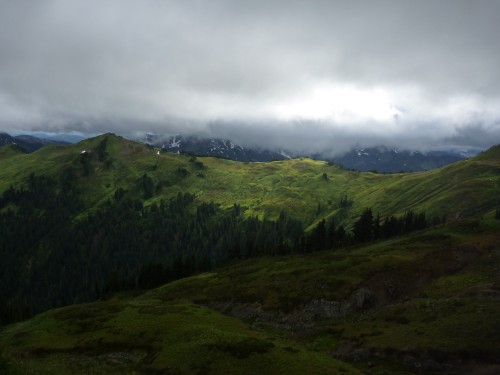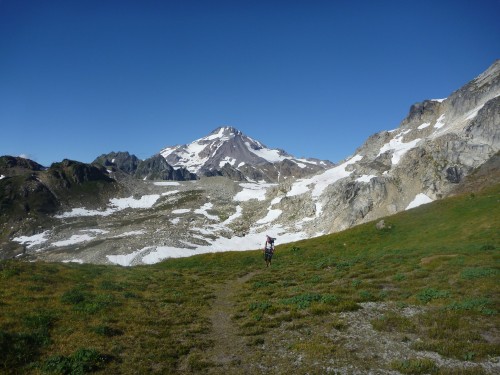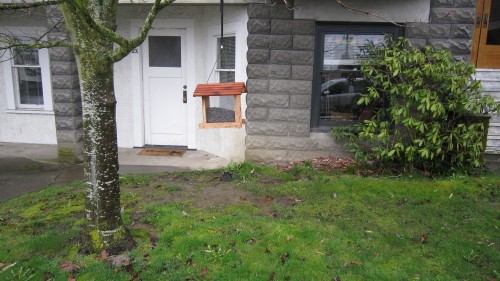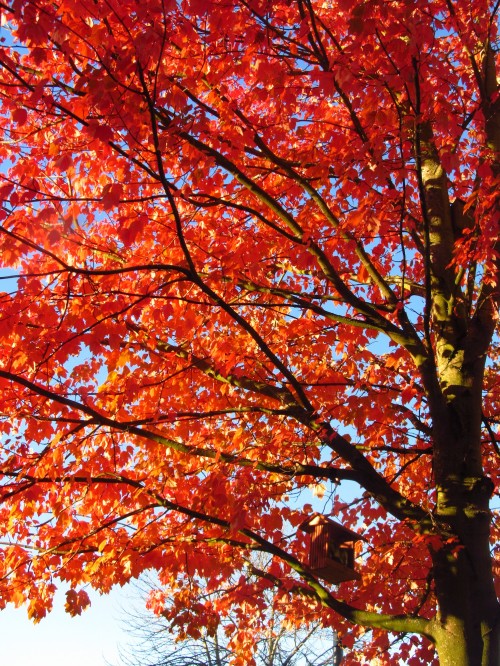The Preservation of the World

Ed. note: The days are getting longer, at least for another week or so. Here is a piece from a former graduate student to inspire you to get out there, both to the big-W wilderness as well as the wilds just outside your door.
By Hillary Schwirtlich
Glacier Peak Wilderness
We huddle from the driving wind under the protection of a band of stunted subalpine firs on the ridgeline near White Pass. My rain jacket is soaked through, again. The clammy synthetic material clings heavy to my arms and I can feel the cold rain seeping through my shoulders and wrists. My bare legs are numb. We ducked under these trees for a moment because we haven’t stopped walking for hours, but we know we can’t stop long or we’ll start to shiver. We’re attempting Glacier Peak for the second time tomorrow. Our first attempt, almost exactly a year earlier, was thwarted by a combination of lack of fitness and a spectacular storm of the kind that creeps like a blanket over the peaks of the Cascades in late summer. We hope our training will help us this time. We walked here from Mexico, we tell ourselves incredulously. The longest approach on a mountaineering trip ever. We can do this.
We stand up and start toward the pass, where the Pacific Crest Trail turns left toward the newly built bridge over the Suiattle River and our detour takes us left through a marmot colony toward Foam Creek. After so long away from cities, our eyes are tuned to pick out anything that doesn’t fit in this landscape, and we spot an orange lump on our route, then two strange figures, brown and white. “What is that?” I ask, and Chris replies, “Llama?”
 A green view of White Pass: What the author imagines when she thinks of Glacier Peak Wilderness. Photo by author.
A green view of White Pass: What the author imagines when she thinks of Glacier Peak Wilderness. Photo by author.
We’ve become a little wild ourselves by this point, and we approach warily. When we get close, the orange dome tent spits out a beanie-topped man, older than us, with a steaming cup in his hand. “Hi!” he beams, and since the rain has let up for a moment, we stop to chat. He’s a hunter, up for the high hunt. He hasn’t seen a single deer or elk, but he says he’s just happy to be where he is. “I’ve been coming to this country for a long time, and these hunts are just an excuse for me to be here, really.” We nod, we know what he means, we’re here for the same reasons. The Glacier Peak Wilderness was — and still is — the landscape my heart escapes to in its daydreams.
Movement has been our default for the last five months and the sun is setting earlier these days, so our restless legs tug us onwards. We wish each other good luck and Chris and I push on, our eyes trained upwards for our path over the ridge, a familiar notch. We leave the cupped, underused trail, climb up and over, then back down, up and down, our steps tracing ancient lava flows from the white giant over the ridge. Finally, we see it: our campsite, a windy plain of moonrock. Then farther, when the clouds clear for an instant, past a patchwork field of rock and snow: a lake of milky greenish water, beside the dirty remains of the White Chuck Glacier. We have been expecting this view, having been temporarily turned around on our previous trip, our climbing party arguing briefly over whether we were in the right basin. The USGS-made map dated from the 1970s showed a blue field of ice where a lake and rubble now was. This was the first place climate change, which I’ve now come to see as the grief, challenge and opportunity of my generation, hit me as something more than just a contested abstract concept.
 Panorama of White Chuck Glacier (left) and the lake where it used to span (right). Photo by author.
Panorama of White Chuck Glacier (left) and the lake where it used to span (right). Photo by author.
We set up camp, giddy to be here, apprehensive about the morning’s weather. We fall asleep to the sound of wind howling across newly exposed glacial deposits. In the morning, the wind is stronger, and though fitness is no longer a factor and the sky clears, we reach a point a thousand feet below the summit when the wind severs my connection with the ground. I find myself flat on my belly, heart pounding, hugging the narrow ridge to keep from being blown away. Only slightly disappointed, we turn around. We still have Canada to look forward to, and this place will always be here.
On our way back down, a deafening roar rumbles from behind and we glance back in time to watch a fighter-jet contour up the white edge of glacier and barrel roll, only feet from the summit. Our legs go wobbly and we feel lightheaded with vertigo. “What if we were up there?” we ask.
 Coming down the mountain. Glacier Peak looms bright in the background. Photo by author.
Coming down the mountain. Glacier Peak looms bright in the background. Photo by author.
Home
I used to have a moss garden. On the cement in front of the door of our north-facing, basement apartment, where only recently the weak spring sunlight has begun to stream through the branches of the rhododendron outside the window, the constant Washington wet would drip off the roof and land muffled and splashless on a bed of bright green moss the size of a dinner plate. When we moved in in September I made up my mind to sculpt it into some aesthetically pleasing shape, but that goal was quickly buried in a sea of grad-student to-dos. So there it stayed, ragged and shapeless and lush.
Until the end of February when a snowstorm left the ground white and left the newly arrived robins with no grass to pick at. The snow on our cement path melted faster than the snow on the grass, and the robins went for the only thing green they could find. I didn’t watch them do it — I only knew because the same thing had happened at my professor John’s house when we arrived at class that day. Bits of moss that had grown on his steps were strewn about his front walkway, strewn about by robins looking for insects and grubs and worms to tug out of the grass.
 The little things: Maple tree flowers outside the author’s front door. Photo by author.
The little things: Maple tree flowers outside the author’s front door. Photo by author.
Now the snow has melted and the buds are breaking on the maple trees in the front yard. Snowdrops — those small white flowers that always know its spring before I do — have pushed themselves up from the cold soil and spread their frost-colored petals to the sky. The other morning, when the snooze on my alarm clock failed to get me out of bed, curiosity about the source of the trilling, musical song outside my window did. A crow calls twice and ruffles its glossy black feathers from the streetlight across the street, and chickadees scold and buzz from the birdfeeder, their eyes bright and black-crowned heads cocked. Nuthatches perch on the lip of the feeder, wary, then choose the largest seed and flit away to ignore gravity on the trunk of a nearby tree.
 The rhododendron bush and the “moss garden” (see left) helping provide a landscape to love, even in town. Photo by author.
The rhododendron bush and the “moss garden” (see left) helping provide a landscape to love, even in town. Photo by author.
For the last six months we’ve lived on this busy street corner and I’ve walked guiltily past the trash that lays in my yard, left by college students walking downtown and blown in from the streets and parking lots around where I live. But while sitting outside the front door on sunny days and behind my window on the much more common rainy ones, I began to notice. I started picking up that trash, respecting this tiny piece of land, surrounded by asphalt and concrete and filled with non-native plants. Because even though it’s a small thing, I know that this is the way I should treat a place that I love. It’s how I treat wilderness, after all.
 Maple tree in the fall, setting the author’s front yard on foliage fire. Photo by author.
Maple tree in the fall, setting the author’s front yard on foliage fire. Photo by author.
Leading photo: Not a llama, but a beanie-topped man the author and her partner, Chris, met on their trek through Glacier Peak Wilderness toward the end of their Pacific Crest Trail adventure.
Hillary Schwirtlich graduated in March from North Cascades Institute and Western Washington University’s M.Ed. program. She is the Southwest and Sierra Program Coordinator for American Alpine Institute, and lives and gardens in Bellingham, Washington. She loves to read, write, climb, hike, paint and cook, and you will usually find her in the Chuckanuts, at Vital Climbing Gym, bike commuting through Boulevard Park or volunteering.

